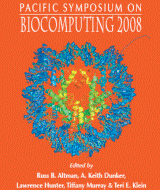Transcript Normalization and Segmentation of Tiling Array Data
Georg Zeller 1, Stefan R. Henz 2, Sascha Laubinger 2, Detlef Weigel 2, Gunnar Rätsch 3
1 Friedrich Miescher Laboratory of the Max Planck Society &
Max Planck Institute for Developmental Biology, Dept. for Molecular Biology
Spemannstr. 35 & 39, 72076 Tšubingen, Germany; 2 Max Planck Institute for Developmental Biology, Dept. for Molecular Biology
Spemannstr. 35, 72076 Tšubingen, Germany; 3 Friedrich Miescher Laboratory of the Max Planck Society
Spemannstr. 39, 72076 Tšubingen, Germany
E-mail: Georg.Zeller@tuebingen.mpg.de; {Stefan.Henz,Sascha.Laubinger,Detlef.Weigel}@tuebingen.mpg.de;
Gunnar.Raetsch@tuebingen.mpg.de
Pac Symp Biocomput. 2008;:527-538.

Abstract
For the analysis of transcriptional tiling arrays we have developed two methods based on stateof- the-art machine learning algorithms. First, we present a novel transcript normalization technique to alleviate the effect of oligonucleotide probe sequences on hybridization intensity. It is specifically designed to decrease the variability observed for individual probes complementary to the same transcript. Applying this normalization technique to Arabidopsis tiling arrays, we are able to reduce sequence biases and also significantly improve separation in signal intensity between exonic and intronic/intergenic probes. Our second contribution is a method for transcript mapping. It extends an algorithm proposed for yeast tiling arrays to the more challenging task of spliced transcript identification. When evaluated on raw versus normalized intensities our method achieves highest prediction accuracy when segmentation is performed on transcriptnormalized tiling array data. Datasets, software and the appendix are available for download at http://www.fml.mpg. de/raetsch/projects/PSBTiling
[Full-Text PDF] [PSB Home Page]